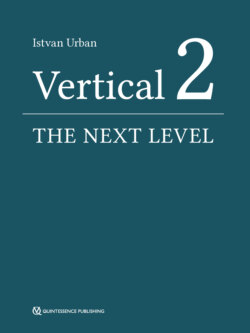Читать книгу Vertical 2: The Next Level of Hard and Soft Tissue Augmentation - Istvan Urban - Страница 33
На сайте Литреса книга снята с продажи.
Agreement with previous studies
ОглавлениеOur case series achieved an absolute vertical bone gain of 5.2 ± 2.4 mm, which matched results reported in two previous case series by the author (IU (using titanium-reinforced d-PTFE membranes with the same bone graft composition that achieved mean height gains of 5.45 and 5.83 mm.8,9 In our study, a relative bone gain of 96.5 ± 13.9% was found, and complete vertical ridge regeneration in 89.2% of cases was achieved. Compared with the results of studies by the same author using nonporous d-PTFE, RPM seems to provide similar or better vertical bone gain.2,8,9
Other studies using titanium-reinforced expanded polytetrafluoroethylene (e-PTFE) membranes reported similar results to ours. Urban et al10 attained a mean height gain of 5.5 mm using titanium-reinforced e-PTFE membrane and autologous bone for maxillary and mandibular, anterior and posterior VBA (staged or simultaneous). Can-ullo and Sisti11 demonstrated a mean height gain of 5.85 mm using titanium-reinforced e-PTFE membranes with magnesium-enriched hydroxyapatite for maxillary and mandibular, anterior and posterior VBA. Todisco12 achieved a mean vertical height of 5.3 mm using titanium-reinforced e-PTFE membranes with xenograft. Clinical VBA studies using nonresorbable membranes consistently report between 4 and 6 mm of vertical bone gain.5,13-15
Although using space-making frameworks, including meshes and GBR membranes, results in fewer complications than distraction osteogenesis or block grafting, flap dehiscence is a chief concern. Absorbable membranes have been associated with more complications than nonresorbable ones.16
This contrast holds true when VBA-only procedures are considered – for these surgeries, absorbable membranes have complication rates of 23%, whereas PTFE membranes have rates of 7%.5 However, not all nonresorbable membranes behave similarly. e-PTFE membranes present with twice the number of complications compared with d-PTFE barriers.5 Our study employing a novel PTFE mesh had a fairly low complication rate (3%). Two complications involved membrane exposure at 1 or 8 weeks post-VBA, which accorded with a previous study reporting early and late exposure (as early as 1 week and up to 6 months postoperatively).16
